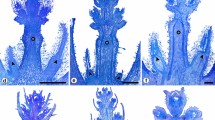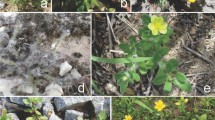Abstract
In contrast toW. Troll's typology of inflorescences which aims at more or less rigid, well defined types, this investigation accentuates the processes that constitute the evolutionary transformations leading from one typical form to another.Troll divided the inflorescences into the two types of monotelic and polytelic synflorescences, the first with a terminal flower on the main axis, the latter with a homogeneous florescence on the indeterminate axis. Both forms are enriched by proximal branches which repeat the structure of the main axis (paracladia). The evolutionary processes leading from the more primitive monotelic type to the advanced polytelic type are truncation (loss of the terminal flower) and homogenization of the distal branches, which thus form a homogeneous florescence. A closer survey of the polytelic groups reveals the fact that, usingTroll's criteria, the same distinction can be found within these groups themselves. Loss of the terminal florescence (truncation of 2nd and higher degree) as well as homogenization of the distal paracladia may lead to florescence-like units of higher complexity. Examples can be found inAsteraceae (Figs. 1 and 2),Fabaceae (Fig. 3 a),Mimosaceae (Fig. 3 b),Acanthaceae, and also in Monocots, as exemplified by theMarantaceae (Figs. 4 and 5). The so-called racemization (inversion of efflorescences from basipetalous to acropetalous) may be mentioned as a third element of transformation, emphasizing the unity of the florescences.—In consequence, there are more organizational levels than reflected in the twoTroll types. The polytelic type comprises several degrees of truncation and homogenization, the basis for a reasonable organizational analysis should therefore be the degree of ramification of flowering branches rather than the mere question of a terminal flower on the main shoot axis (Fig. 6). On the other hand the three processes of truncation, homogenization and racemization are evolutionary transformations that may occur independently from one another, thus giving rise to a large number of variations, which can not be satisfactorily interpreted by exactly defined types. On the basis of these considerations the question of homologous parts in inflorescences is reviewed. The homology of partial florescences and paracladia is accentuated contrary toTroll's interpretation (Fig. 7). Homogenization as an evolutionary trend may transform paracladia of different degree of ramification, leading to one-flowered units on the one side and to highly complex structures as in theMarantaceae on the other.
Similar content being viewed by others
Literatur
Andersson, L., 1976: The synflorescence of theMarantaceae. — Bot. Not.129: 39–48.
—, 1977: The genusIschnosiphon (Marantaceae). — Opera Bot.43: 1–113.
Froebe, H. A., 1982: Homologiekriterien oder Argumentationsverfahren? — Ber. Deutsch. Bot. Ges.95: 19–34.
Günther, K. F., 1975: Beiträge zur Morphologie und Verbreitung derPapaveraceae. 1. Infloreszenzmorphologie derPapaveraceae, Wuchsformen derChelidonieae. — Flora164: 185–234.
Hagemann, W., 1973: Typologie und Phylogenie. — Aufsätze u. Reden senckenb. naturf. Ges.24: 47–61.
Kunze, H., 1969: Vergleichend-morphologische Untersuchungen an komplexen Compositen-Blütenständen. — Beitr. Biol. Pfl.46: 97–154.
—, 1985: Die Infloreszenzen derMarantaceen und ihr Zusammenhang mit dem Typus derZingiberales-Synfloreszenz. — Beitr. Biol. Pfl.60: 93–140.
—, 1986: Infloreszenz- und Blütenmorphologie vonOrchidantha maxillarioides (Ridl.)K. Schum. (Lowiaceae). — Beitr. Biol. Pfl.61: 221–234.
Loesener, T., 1930:Marantaceae. — InEngler, A., Prantl, K., (Eds.): Die natürlichen Pflanzenfamilien15 a, 2. Aufl., pp. 654–693. — Leipzig, Berlin: Engelmann.
Maresquelle, H. J., 1970: Le theme évolutif des complexes d'inflorescences. Son aptitude à susciter des problèmes nouveaux. — Bull. Soc. Bot. Fr.117: 1–4.
—, 1971: Evolutionstendenzen bei komplexen Infloreszenzsystemen. — Ber. Deutsch. Bot. Ges.84: 187–188.
Schroeder, F. G., 1986: Gedanken zur Definition der Begriffe Infloreszenz und Synfloreszenz. Referat Symposium „Grundsatzfragen der Pflanzenmorphologie“, 7.–9. 3. 1986, Aachen.
—, 1987: Infloreszenzen, Synfloreszenzen und Moduln. Ein terminologischer Beitrag zur Infloreszenzmorphologie. — Bot. Jahrb. Syst.108: 449–471.
Sell, Y., 1969: Les complexes inflorescentiels de quelquesAcanthacées. — Ann. Sc. Nat. Bot.10: 225–300.
—, 1976: Tendences évolutives parmi les complexes inflorescentiels. — Rev. Gén. Bot.8: 247–267.
—, 1980: Physiological and phylogenetic significance of the direction of flowering in inflorescence complexes. — Flora169: 282–294.
Stauffer, H. U., 1963: Gestaltwandel bei Blütenständen von Dicotyledonen. — Bot. Jahrb. Syst.82: 216–251.
Troll, W., 1950: Über den Infloreszenzbegriff und seine Anwendung auf die krautige Region blühender Pflanzen. — Abh. Akad. Wiss. Lit. Mainz, math.-nat. Klasse15: 377–415.
—, 1961:Cochliostema odoratissimum Lem. Organisation und Lebensweise. — Beitr. Biol. Pfl.36: 325–389.
—, 1964a: Die Infloreszenzen, Typologie und Stellung im Aufbau des Vegetationskörpers1. — Stuttgart: G. Fischer.
—, 1969: Die Infloreszenzen, Typologie und Stellung im Aufbau des Vegetationskörpers2. — Stuttgart: G. Fischer.
—, 1950ff.: Kommission für biologische Forschung. Bericht. — Jahrb. Akad. Wiss. Lit. Mainz. Jb. 1953: 39–45 (1953); Jb. 1957: 39–50 (1958); Jb. 1967: 127–144 (1959); Jb. 1963: 113–137 (1964b); Jb. 1965: 109–133 (1966); Jb. 1967: 89–103 (1968); Jb. 1973: 135–151 (1974); Jb. 1974: 128–142 (1975).
Weberling, F., 1961: Die Infloreszenzen der Valerianaceen und ihre systematische Bedeutung. — Abh. Akad. Wiss. Lit. Mainz, math.-naturw. Kl.5: 150–268.
—, 1963: Homologien im Infloreszenzbereich und ihr systematischer Wert. — Ber. Deutsch. Bot. Ges.76: 102–112.
—, 1981: Morphologie der Blüten und der Blütenstände. — Stuttgart: E. Ulmer.
Author information
Authors and Affiliations
Rights and permissions
About this article
Cite this article
Kunze, H. Probleme der Infloreszenztypologie vonW. Troll . Pl Syst Evol 163, 187–199 (1989). https://doi.org/10.1007/BF00936514
Received:
Issue Date:
DOI: https://doi.org/10.1007/BF00936514




